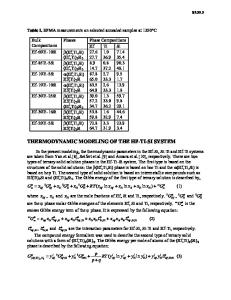Magnetic contributions to the thermodynamic functions of alloys and the phase equilibria of Fe-Ni system below 1200 K
- PDF / 1,148,879 Bytes
- 12 Pages / 594 x 774 pts Page_size
- 42 Downloads / 337 Views
0.400) .662K a(x2 = 0.063) + yz(x2 = 0.463)
The existence of the miscibility gap is due to the magnetic Gibbs energy term of the fcc phase which is composition dependent. Experimental results reported in the literature support the predicted miscibility gap.
I.
INTRODUCTION
THEimportance
of magnetic contribution to the stabilities of magnetic metals and alloys was recognized long ago by Zener I and has been studied by many other authors 2-~2with an enhanced interest in recent years. Very recently, a twoparameter equation was proposed by Chuang, Schmid, and Chang 13to describe accurately the magnetic specific heats of Ni, Co, and Fe. One of the parameters is the Curie temperature, To, and the other is related to the degree of saturation of magnetization. Moreover, the specific heat equation can be integrated readily to obtain simple mathematic equations in closed form for the corresponding entropy, enthalpy, and Gibbs energy terms. Chuang et al. 14 used the same approach to describe the magnetic contribution to the thermodynamic functions of a-(Fe, Cu) alloys with the bcc structure. Since the solubility of Cu in a-Fe is small, and since Harvig, Kirchner, and Hillert 15 and Kubaschewski, Smith, and Bailey 16 had used an alternate approach 1'3 to describe the a-(Fe, Cu) alloys with equal success, it is important to demonstrate that this approach is equally applicable to other magnetic alloys where the solubility of the alloying element is large. The Fe-Ni binary is an obvious system to be studied in order to test the suitability of the present approach. According to the known phase diagram, 17'18 the y-(Fe, Ni) alloys with the fcc structure are ferromagnetic at low temperatures. The Curie temperature T~ increases from 631 K for pure Ni to a maximum value of 885 K at - 6 8 at. pct Ni and then decreases to -693 K at - 4 2 at. pct Ni. If this approach can describe accurately the magnetic contribution to the thermodynamic functions of YING-YU CHUANG. Project Associate, Y. AUSTIN CHANG, Professor and Chairman, and JEN-CHWEN LIN, Research Assistant, are with the Department of Metallurgical and Mineral Engineering, University of Wisconsin-Madison, 1509 University Avenue, Madison, WI 53706. RAINER SCHMID is with Technical University Clausthal, West Germany. Manuscript submitted June 24, 1985. METALLURGICAL TRANSACTIONS A
the y-(Fe, Ni) alloys, it may be used with confidence for many other metallic alloys where the Curie temperature usually changes monotonically with alloying composition. The objectives of the present paper are (1) to formulate a generalized approach to describe the magnetic contribution to the thermodynamic properties of binary and higher order magnetic alloys, (2) to apply this approach specifically to 7-(Fe, Ni) and a-(Fe, Ni) alloys, (3)to calculate/predict phase equilibria of Fe-Ni below 1200 K, and (4) to interpret much of the experimental results reported in the literature on the Invar (Fe, Ni) alloys in terms of the predicted miscibility gap of the y-(Fe, Ni) phase at low temperatures. Solution pa
Data Loading...











